Metaverse has become a sensation across the world.
While it has been taking over the hearts (and heads) of users, it also opens many great opportunities for businesses across the world.
Especially fintech.
Payments in digital wallets have become a huge niche that may hold billions of dollars.
So, what is it all about?
That’s exactly what we shall be discussing in this blog.
Therefore, with this being said, let’s start with a basic introduction to the virtual world of Metaverse:
Understanding Metaverse
So, what is Metaverse?
The metaverse is an expansive network of persistent, real-time rendered 3D worlds and simulations that support continuity of identity, objects, history, payments, and entitlements.
It offers users a virtual space where they can interact, work, and play.
As this digital universe grows, integrating effective payment systems becomes essential.
For eWallet and fintech companies, understanding the metaverse is the first step towards tapping into its vast economic potential, where transactions are not just frequent but integral to the virtual experiences they enable.
Rise of Metaverse Payments
As the metaverse continues to grow, the complexity and scope of its transactions are also expanding.
From buying virtual real estate to handling microtransactions for digital goods and services, the significance of payment solutions in the metaverse is increasingly essential.
Currently, familiar payment solutions like PayPal and debit cards are prevalent, but there is a notable shift towards the adoption of cryptocurrencies and stablecoins, emphasizing the need for secure, scalable, and efficient eWallet systems designed for the metaverse.
The financial potential of the metaverse is substantial, with market size projections by McKinsey & Company estimating it could reach up to $5 trillion by 2030.
This anticipated growth signals a lucrative market ripe for innovative eWallet solutions
Especially those that leverage blockchain technology, making it high time to build a crypto wallet.
These technologies enhance security and improve the overall user experience within digital environments.
As metaverse payment methods evolve, eWallets stand to play a pivotal role in not only supporting the current digital economy but also in facilitating new economic models and opening up fresh opportunities within these expansive virtual worlds.The Role of Digital Payments in the Metaverse
So, what is the Role of Digital Payment in Metaverse?
Well, over the years, digital payments have become integral to the functioning of the metaverse, acting as the backbone of its rapidly growing economy.
Within these virtual spaces, transactions go beyond mere convenience to become essential, facilitating everything from simple purchases of virtual goods to more complex transactions like property acquisitions and contractual services.
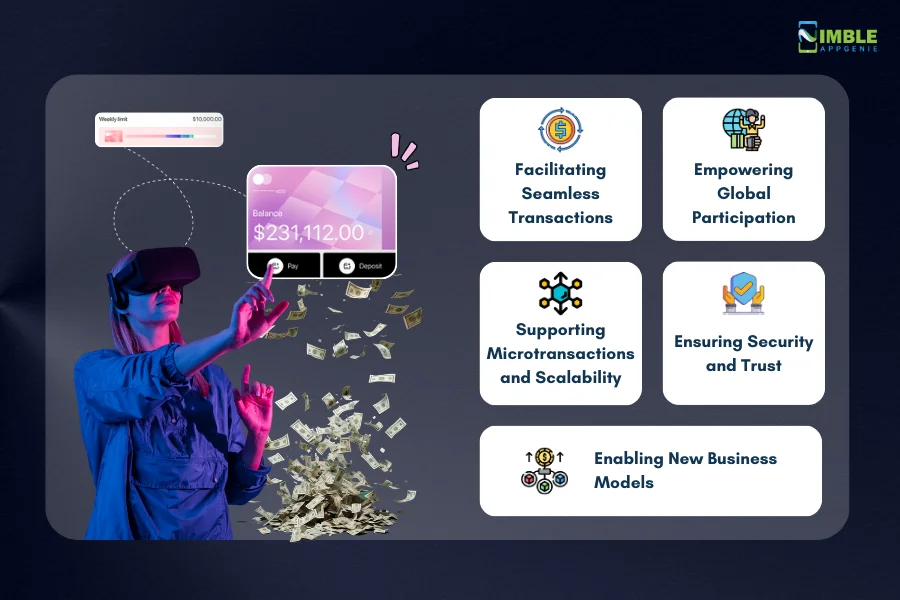
To better understand this, here are several key metaverse payment use cases:
-
Facilitating Seamless Transactions
Nobody knew about Mobile payments technology 10 years ago, and today, they have taken over the world.
Metaverse payment system is going through the same transaction.
In the metaverse, users expect transactions to be as seamless and integrated as their virtual experiences.
eWallets support this seamless integration, allowing users to conduct transactions without disrupting their engagement in the virtual environment, thus maintaining immersion and continuity.
-
Empowering Global Participation
The metaverse eliminates geographical boundaries, uniting a global audience.
eWallets are crucial in this context by enabling users from various parts of the world to engage in economic activities without the friction of currency exchange or traditional banking limitations.
This global reach is particularly enhanced by eWallets that support cryptocurrencies and utilize blockchain technology.
Thus, providing a universal medium of exchange.
-
Support for Microtransactions and Scalability
The dynamic interactions within the metaverse often necessitate efficient handling of microtransactions, whether buying a virtual coffee or customizing an avatar.
eWallet payments in metaverse facilitate these small, frequent transactions, giving developers and users the flexibility to price products and services appropriately and scale operations as needed.
-
Ensuring Security and Trust
ewallet security is paramount in the metaverse.
Here, digital identities and virtual assets hold significant value.
Digital wallet driven metaverse payments leveraging blockchain technology offer enhanced security features such as encryption and smart contracts.
These features help build trust among users by ensuring that transactions are not only secure but also transparent and tamper-proof.
-
Enabling New Business Models
Metaverse is a breeding ground for innovative fintech business models, many of which depend on robust digital payment systems.
Digital wallets enable a variety of business structures to thrive in virtual environments, from subscription services to pay-as-you-go models for premium content, by providing reliable and adaptable payment solutions.
With the role out of the way, let’s look at the different types of payments in Metaverse.
(Expected) Types of Payment in Metaverse
In the real world, we have different types of digital payment via eWallet.
For instance, P2P online payments, contactless payment, bank-to-bank transfer, and so on.
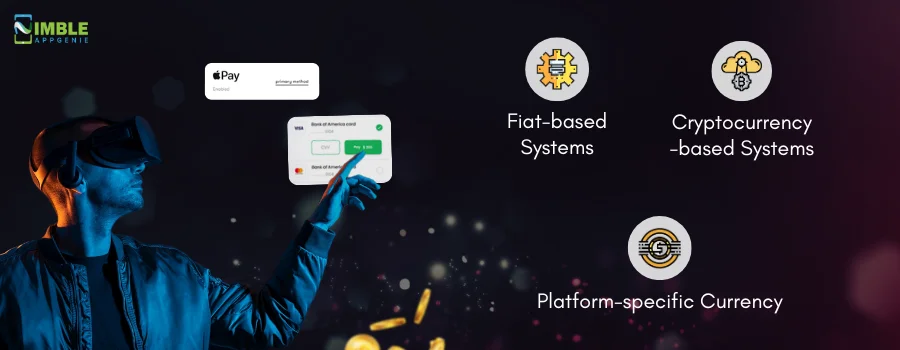
Similarly, in Metaverse, we expect different forms of payment. Confused? Well, let’s explore the same in layman’s terms below:
Type 1: Fiat-based Systems
Fiat-based payment systems in the metaverse mirror traditional online payments.
This technology utilizes familiar methods such as credit cards, the best digital wallet apps, and bank transfers.
These systems are user-friendly, offering a seamless transition for those accustomed to conventional transactions. They provide security and reliability but may not fully capitalize on the unique capabilities of the metaverse.
For example, seamless cross-border transactions and efficient microtransactions that eWallets can enhance with additional metaverse-specific features.
Type 2: Cryptocurrency-based Systems
Cryptocurrencies are gaining traction in the metaverse for their ability to enable secure, transparent, and rapid transactions without intermediaries.
Metavere payments backed by blockchain technology offer reduced transaction fees and enhanced privacy.
Such eWallets are ideal for the metaverse, facilitating transactions across diverse platforms and international borders effortlessly, catering to the decentralized nature of these virtual spaces.
Type 3: Platform-specific Currency
Many metaverse platforms are introducing their own specific currencies, also known as metaverse payment tokens, designed exclusively for use within their virtual worlds.
Digital payments via eWallet integrating these platform-specific currencies can offer tight integration with the platform’s eWallet features, including loyalty rewards and special access, enhancing user engagement and fostering a self-contained economy.
Although their utility might be limited outside their respective platforms, eWallets can provide essential services like currency management and exchange
Thus, bridging the gap between different virtual and real-world financial systems.
Opportunities for eWallet Companies in the Metaverse
Want to start an eWallet startup or expand an existing business?
One of the biggest opportunity in past few decades that has presented itself is metaverse payment solutions.

Let’s see what are the opportunities that await you:
-
Developing Tailored eWallet Solutions
eWallet firms have a unique opportunity to develop an eWallet app specifically for Metaverse and lead the charge.
These solutions can manage everything from traditional fiat-based transactions to advanced blockchain technologies
Thus, accommodating a diverse user base and various transaction types within these virtual worlds.
-
Integrating Blockchain and Cryptocurrencies
The push to utilize blockchain technology and cryptocurrencies is significant within the metaverse.
Fintech companies that drive payments in metaverse can spearhead this shift by offering eWallets that facilitate cryptocurrency transactions, smart contracts, and even NFT (Non-Fungible Token) trades.
This will ensure secure and transparent dealings.
-
Enhancing User Experience With AI
Artificial intelligence (AI) in digital wallets can greatly enhance the financial user experience in the metaverse.
eWallet providers can employ AI to deliver personalized financial advice, automate customer service through intelligent fintech chatbots, and optimize transaction processes
This will make them quicker and more efficient.
-
Expanding Cross-border Transactions
Metaverse’s global nature removes geographical barriers, allowing users from different parts of the world to interact and transact seamlessly.
There are several cross-border payment apps are already doing it.
Digital payment providers in metaverse can leverage this by offering eWallet solutions that facilitate smooth cross-border payments, tackling challenges related to currency conversion, transfer speeds, and regulatory compliance.
-
Creating Platform-specific Financial Products
Each metaverse platform may have its own unique features and requirements, presenting an opportunity for fintech firms to create specialized financial products and services tailored to these environments.
This could include platform-specific eWallets, currencies, and investment products.
Or if you are new to the market, consider starting a fintech business that targets this specific market with a product.
-
Ensuring Compliance and Security
Lastly, let’s talk about fintech regulations and compliance.
With great opportunity comes great responsibility, particularly in ensuring compliance with various financial regulations and security standards.
eWallet providers can position themselves as leaders in offering secure, compliant financial services in the metaverse, helping to shape regulatory frameworks and build trust with users.
Why Invest in Metaverse Payment Solutions?
When metaverse was new, a lot of businesses wanted to develop a virtual world using the unreal engine.
But today, it’s a bit different.
Businesses and startups alike, instead of competition with Metaverse are developing solutions for it. One of these opportunities is Metaverse payment system.
Should you invest in Metaverse payment products?
Well, the short answer to this is, yes.
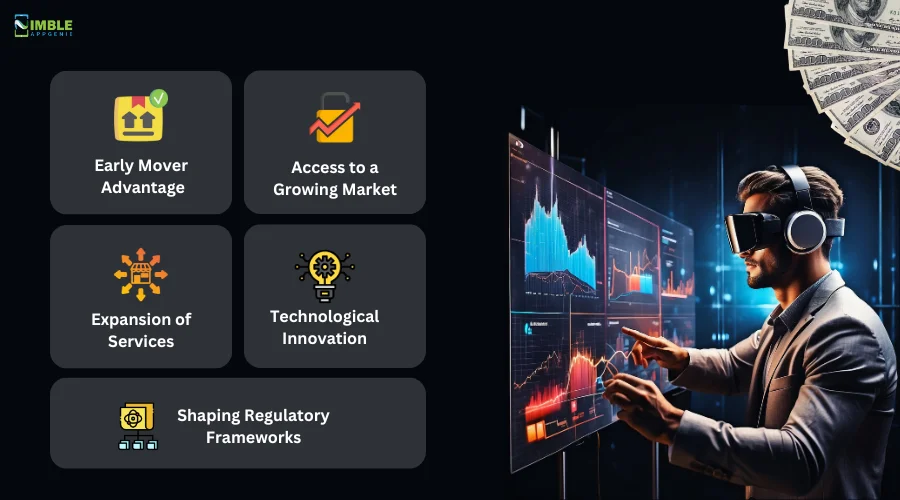
As for the longer one, let’s discuss that below:
1. Early Mover Advantage
Ever heard of the term “First comes, first served”? That’s what’s going on in the metaverse – ewallet market today.
The metaverse is in its nascent stages, with its financial infrastructure still developing.
By investing early in eWallet solutions for the metaverse, fintech companies can secure a significant competitive edge as technology matures and user adoption grows.
2. Access to a Growing Market
Fintech statistics project that the economic impact of the metaverse could reach up to $5 trillion by 2030.
The expanding user base and increasing transaction diversity within the metaverse represent a lucrative market for innovative eWallet solutions.
So, if you want to make money with your digital wallet, this is the right time to go for it.
3. Expansion of Services
Growth is the nature of the business.
This is one of the biggest growth opportunities in the past many years. Metaverse offers fintech companies a unique opportunity to broaden their services.
This covers everything from traditional payment processing to more advanced offerings like smart contracts, digital asset management, and decentralized finance (DeFi) solutions, all of which are well-suited for virtual environments.
That’s one of the reasons to go for metaverse payment solutions.
4. Technological Innovation
Investing in metaverse payment systems propels technological advancements in blockchain, AI, and cybersecurity.
These technologies not only enhance the functionality and security of eWallets in the metaverse but also have broader applications that could transform traditional financial operations.
Also Read: eWallet App Tech Stack
5. Shaping Regulatory Frameworks
Metaverse is a new frontier with evolving regulatory needs.
Early participants in metaverse payment solutions have a better opportunity to influence and adapt to these frameworks as they develop, ensuring compliance and potentially guiding best practices.
In layman’s terms, it’s time to shape next-age digital payment regulations.
Case Studies/Examples
Now, if you are planning to go for the opportunities, there will be a lot of questions.
For instance, why do eWallet startups fail? How can I be successful?, and so on. Well, luckily for us the market is filled with lessons for fintech startups.
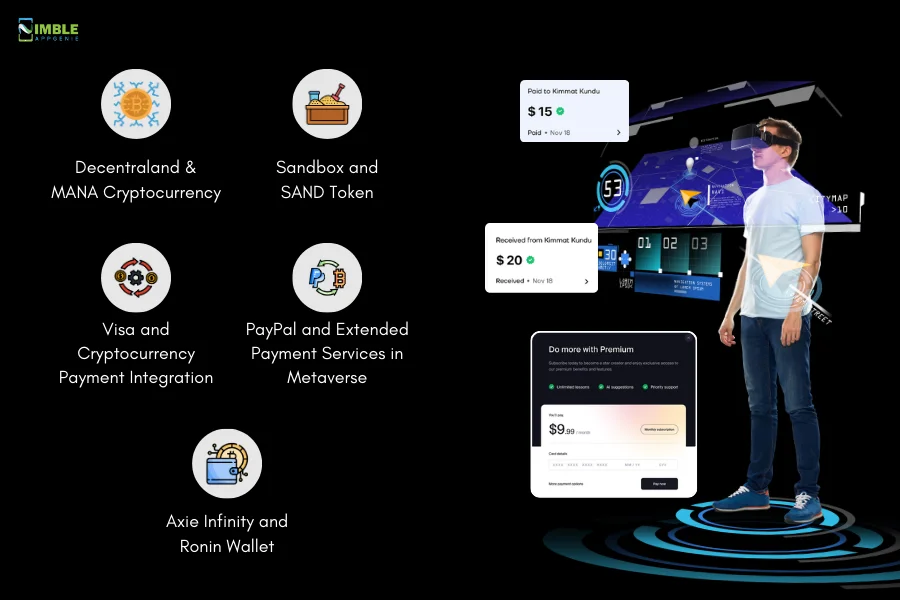
Decentraland and MANA Cryptocurrency
Decentraland is a virtual reality platform powered by the Ethereum blockchain, where users can create, experience, and monetize content and applications.
The platform uses MANA, its own cryptocurrency, to facilitate payments in metaverse.
This demonstrates how native cryptocurrencies, managed through eWallets, can be integral to economic transactions in virtual environments.
Also Read: Common Reasons Why Digital Wallet App Startups Fail
-
Sandbox and SAND Token
Sandbox is another blockchain-based virtual world that allows users to create, build, buy, and sell digital assets in the form of a game.
The use of SAND, an ERC-20 utility token, within this ecosystem demonstrates the functionality of platform-specific currencies.
These metaverse payment tokens can be managed through specialized eWallets, enhancing transactions and interactions with user-generated content and governance through decentralized autonomous organizations (DAOs).
-
Visa and Cryptocurrency Payment Integration
Visa has entered the metaverse through various initiatives, including partnering with blockchain technology companies to facilitate cryptocurrency transactions.
Their approach not only includes enabling crypto payments but also exploring NFTs as a form of engagement and investment.
Visa’s integration into these areas highlights how traditional financial entities are adapting to the emerging needs of the metaverse, including the use of eWallets for handling diverse forms of digital currency.
Also Read: Here’s Why Fintech Startups Fail – Lessons, Dos, & Don’ts
-
PayPal and Extended Payment Services in Metaverse
PayPal has shown interest in expanding its payment services to include metaverse, aiming to ensure secure and efficient payment methods across these new platforms.
Their involvement indicates a significant shift where established payment processors are preparing to support digital transactions in immersive digital environments through eWallets.
-
Axie Infinity and Ronin Wallet
Axie Infinity, a blockchain-based trading and battling game, is notable for its high level of player engagement and substantial economic activity.
It uses Axie Infinity Shards (AXS) and Smooth Love Potion (SLP) as in-game currencies, managed through the Ronin Wallet—a sidechain eWallet that helps in reducing transaction fees and processing times.
This setup is an excellent example of how tailored blockchain solutions can support vibrant and complex economic activities within the metaverse.
Challenges and Considerations
While the opportunities in metaverse payment solutions, particularly eWallets, are substantial, there are several challenges and considerations that need to be addressed to ensure their successful implementation and operation.
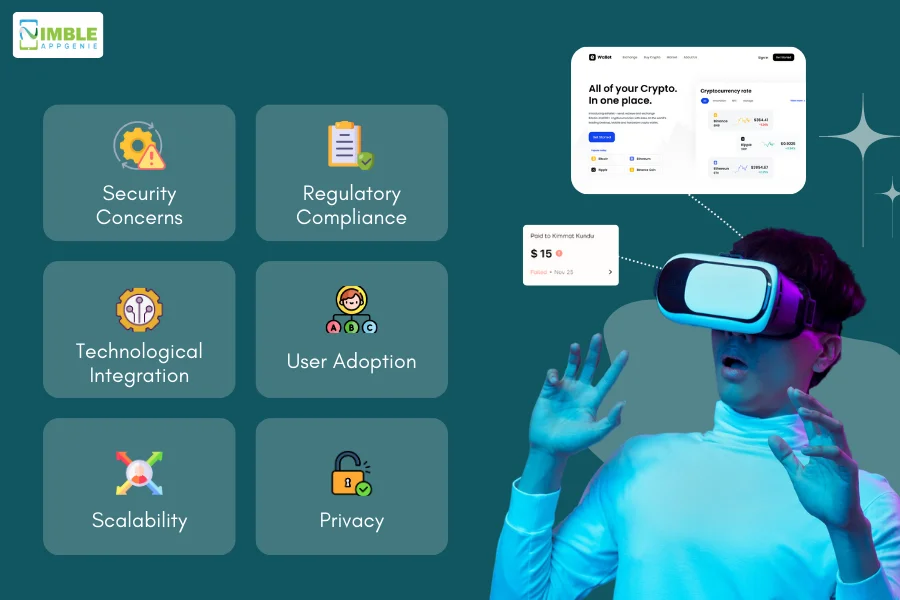
So before you build a fintech app and enter the Meta-Market, here’s what you need to vary off:
1. Security Concerns
The digital nature of the metaverse makes it a prime target for various cyber threats, including fraud, hacking, and data breaches.
Ensuring robust security protocols and implementing advanced cybersecurity measures in eWallets are crucial to protect user data and transactions.
This involves using state-of-the-art encryption, secure authentication methods, and continuous monitoring for vulnerabilities.
2. Regulatory Compliance
The regulatory landscape for digital payments in the metaverse is still in development.
eWallet providers must navigate a complex framework of laws and regulations that can vary significantly across different jurisdictions.
Compliance is essential not only to avoid legal repercussions but also to maintain user trust and ensure stable operations.
3. Technological Integration
Integrating existing payment systems, especially eWallets, with new, often complex metaverse platforms can pose significant technical challenges.
Ensuring compatibility and smooth operation across different technologies is crucial for providing a seamless user experience.
This may involve developing APIs that allow for easy integration of eWallets with various metaverse environments.
4. User Adoption
Despite its growing popularity, the metaverse is still a relatively new concept to many.
Driving widespread adoption of metaverse platforms and their associated eWallet payment systems requires user education and demonstrating clear value and benefits.
eWallet companies might need to engage in targeted marketing campaigns and user-friendly designs to ease the transition for new users.
Also Read: Maximizing User Retention in Payment Apps
5. Scalability
As the metaverse continues to expand, digital payments in metaverse must be able to scale effectively to handle an increasing number of transactions without compromising performance or security.
This involves using cloud technology, scalable blockchain solutions and robust data handling capabilities to manage growth in user numbers and transaction volumes.
6. Privacy
Maintaining user privacy in the highly interconnected digital world of the metaverse is a significant challenge.
Digital payment providers in Metaverse must ensure that personal data is protected and that users retain control over their information.
This means implementing strict data protection policies, using privacy-enhancing technologies, and ensuring transparency in data usage and storage.
Nimble AppGenie Helping Fintech Startups Rule the Virtual World
Do you want to enter Metaverse with your digital payment solution?
Nimble AppGenie is here to help you.
As a market leading digital payment app development company, we have helped more than 250 clients across the world realize their fintech dreams.
Being the development force behind top names like Cut Wallet, SatPay, and SetBorsa, we know what it takes to develop the next best.
Consult us and start your Metaverse journey.
Conclusion
In this blog, we explored the integration of eWallets within the metaverse highlights their pivotal role in shaping the future of virtual economies.
As the metaverse evolves, digital wallets stand at the forefront of technological innovation, offering secure, efficient, and adaptable payment solutions.
For investors and fintech companies, the time is ripe to capitalize on this burgeoning market, ensuring they not only participate in but also drive the dynamic expansion of digital commerce and interactions in these expansive new digital realms.
FAQs
In the metaverse, payments operate similarly to real-world transactions but take place within virtual environments. Users can utilize various digital payment systems, including traditional fiat currencies, cryptocurrencies, or platform-specific tokens. These transactions are typically facilitated through digital wallets and eWallets, often secured with blockchain technology to ensure transparency and security.
Money in the metaverse can be obtained through several methods: purchasing virtual currencies directly with fiat money, earning through participation in the virtual economy (selling goods, services, or earning rewards), or exchanging cryptocurrencies. eWallets often facilitate these transactions, and some platforms may offer currency conversion features to ease transactions across different virtual environments.
A variety of payment platforms are employed in the metaverse, tailored to the specific needs and capabilities of each virtual environment. Popular options include eWallets like PayPal, traditional banking services, and cryptocurrency wallets such as MetaMask or Ronin. These platforms support secure and efficient fund transfers, adapting to the unique demands of metaverse transactions.
The best digital wallet for the metaverse depends on the user’s specific needs and transaction types. Wallets like MetaMask are highly recommended for their compatibility with Ethereum-based transactions and NFTs, suitable for platforms using these technologies. For a broader range of cryptocurrencies or enhanced privacy features, wallets like Trust Wallet or Ledger might be more appropriate.
The reversibility of transactions in the metaverse depends on the payment method used. Transactions made with cryptocurrencies are generally irreversible due to blockchain technology. However, some metaverse platforms might implement mechanisms to reverse transactions under specific conditions, such as fraudulent activities or system errors.
Yes, transaction fees can apply in the metaverse, similar to traditional digital payments. The amount of these fees varies based on the payment platform, the type of currency used, and the nature of the transaction. Cryptocurrency transactions may incur network fees that depend on the current network congestion and transaction complexity.
Security for metaverse payments typically relies on the underlying technology of the payment system used. Cryptocurrency-based transactions offer high security due to encryption and blockchain technology. eWallets and other payment platforms must also implement robust security measures to protect users from potential threats like hacking or phishing attacks.
Implementing a universal payment system in the metaverse faces several challenges, including ensuring interoperability between different virtual environments, managing exchange rates between diverse currencies, and complying with international regulatory frameworks. Additionally, achieving widespread adoption and maintaining robust security standards are critical obstacles.
Currency exchange in the metaverse can be facilitated through built-in exchange services within platforms or via external cryptocurrency exchanges. These services allow users to convert between different forms of digital currencies, including fiat to crypto conversions, to engage in transactions across various platforms.

Niketan Sharma is the CTO of Nimble AppGenie, a prominent website and mobile app development company in the USA that is delivering excellence with a commitment to boosting business growth & maximizing customer satisfaction. He is a highly motivated individual who helps SMEs and startups grow in this dynamic market with the latest technology and innovation.
Table of Contents




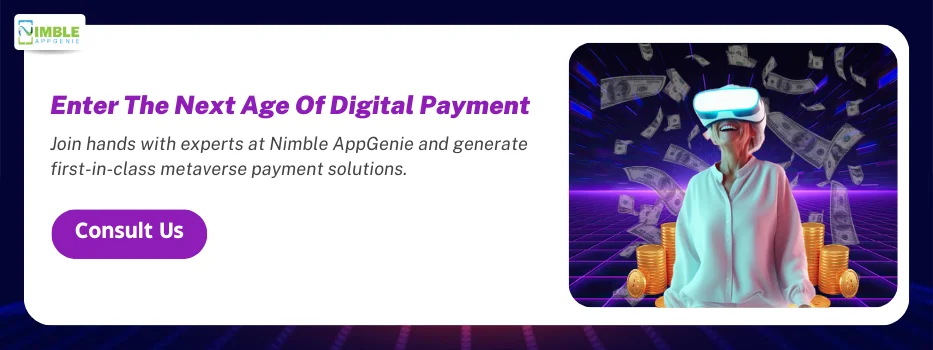
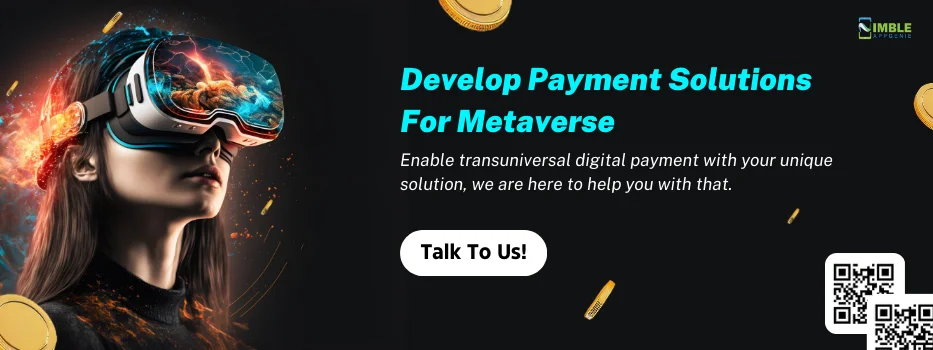
No Comments
Comments are closed.